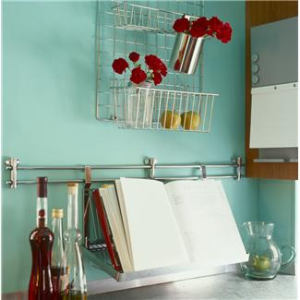 In a quest for a healthy and truly gluten-free kitchen, you will read over and over about how important it is to keep things separate, to avoid using the same utensils (major cross contamination no-no) and even to store your bakeware in separate cabinets.
In a quest for a healthy and truly gluten-free kitchen, you will read over and over about how important it is to keep things separate, to avoid using the same utensils (major cross contamination no-no) and even to store your bakeware in separate cabinets.
Now, I can’t say that we follow those guidelines as we didn’t find them practical for us, so here are a few that I do suggest:
1. Use a spoon to scoop out the peanut butter (sub any ‘spreadable’ here) before you spread it on anything. I started off doing this just when spreading onto my husbands traditional bread, but then realized the concept was important because crumbs make their way back into the jar, and I started to find that concept to be pretty gross, so in the end, I use a spoon to scoop out all my spreadables regardless of where they’ll end up. 🙂
2. If you’re making traditional and gluten-free items at once, definitely use a separate utensil for each.
3. Whenever possible, make it gluten-free. While my husband hasn’t fully switched over to a gluten-free lifestyle, he has chosen to cook gluten-free for ease of us all being able to eat together without worry.
One of the bigger challenges you will face is avoiding the ever-present cross contamination. When living in a household that isn’t entirely gluten-free, you will want to take certain steps to ensure that you avoid some of the more common mistakes off the bat.
Namely, reusing utensils in “spreadables” (butter, margarine, nut butters, etc) which you are likely to spread on both gluten containing and gluten-free “spreadables”. One sure-fire way to avoid contaminating the gluten-free version is to buy 2 separate containers, labeling one GF. This way everyone will know not to use that unless its to spread on some yummy gluten-free bread, pastry, etc.
Other tips: using a toaster oven to avoid mixing of crumbs, using sharpies, foil as your friend, separating your flours, frequent hand washing and more. While it seems like a lot to start, these tips will become second-nature to you in no time, and will spare you much unneeded discomfort and allergic results!
- Eliminate questions with permanent markers. If you’ve called a manufacturer to confirm that a product is, in fact, gluten-free, mark it up. Use a permanent marker and write “GF” so visitors or kids won’t have any questions.
- Crumbs are crummy; they can completely annihilate a perfectly good gluten-free meal. Not only can they end up in tubs and jars of spreadables like margarine or peanut butter, but if you’re preparing a gluten-free sandwich and you set it down in a pile of “regular” crumbs, or if you cut it with the same knife used on a “regular” sandwich, all of your efforts to prepare a gluten-free meal were for naught. Be sure to wipe preparation surfaces carefully, and use clean knives and utensils when preparing your meals.
- Use toaster ovens! It would be virtually impossible to share toasters and have your gluten-free toast come out completely gluten-free. Toaster ovens are better because the crumbs fall down and out of contact from the bread. I’d still recommend either wiping down the grills between toasting or having separate toasting ovens.
- Store your own flours separately. If you keep gluten-free and “regular” flours in your kitchen or pantry, store them separately and mark them clearly, especially if you transfer your flours into your own storage containers. It’s nearly impossible to tell which flours are gluten-free just by looking, so marking them is essential. But keeping them separated will help, too. And of course, if you’re cooking with both, provide lots of separation. Flour drifts, and can easily ruin a perfectly good gluten-free meal.
- Foil is your friend! Prepare to use more aluminum foil than you’re used to. It’s safest to cook on aluminum foil and throw it away when you can. Foil is also good for separating the different types of food you’re cooking, and it’s easy to clearly identify different foods by writing on aluminum foil with your friend the permanent marker.
To read more helpful tips, see some of the sites I like here!
Yes, friends, it takes a bit more preperation and organization to maintain a healthy gluten-free home, but in the end, these new tips will become second nature to you and will make your life so much easier while allowing you to be confident that you’re preserving yours (or the other gluten intolerant loved ones in your home) safe from harm.
Because in the end, your health is far more important than the small inconvenience you’re about to embark upon!
Comments Closed